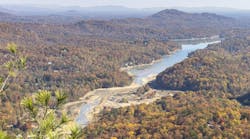
As with many other cities that have combined sanitary and storm sewer systems, Chicago has a combined sewer overflow problem, with an average of more than 60 overflows a year. And, as many other cities are doing, it’s turning to green infrastructure to help solve the problem—infiltrating as much water as possible to keep runoff out of the now-undersized and overburdened sewer system during storms. In addition to traditional methods of dealing with runoff and wastewater, Chicago and other cities are looking to smaller, decentralized solutions.
Chicago has taken some early and visible steps toward green infrastructure, such as its Green Alley program and the famous green roof atop its City Hall. One thing the city is doing that some others are not is taking active measures to see how well green infrastructure is working. It’s notoriously difficult to do.
Several years ago, Gordon England wrote an article for Stormwater magazine outlining how more widespread use of green infrastructure (then commonly referred to as low impact development) would affect municipal development processes, as well as the difficulties of inspecting and maintaining these widely dispersed installations. Who’s responsible for long-term maintenance on single-family residential properties, for example? The city, the homebuilder, the homeowner, or some combination?
Maintenance is only part of the question. How can we be sure the many individual green infrastructure measures—bioswales, areas of permeable pavers, and so on—are removing as much volume from the system as intended? Even with the best design, who’s checking to ensure they’re still working as efficiently as they should after several years—that the media in the rain gardens and swales hasn’t clogged with silt, or that some of the residential rain gardens haven’t been completely replaced by the homeowners?
Questions like these make some strong proponents of LID and green infrastructure touchy, as we’ve seen from the responses to England’s article and others. But they’re necessary, and Chicago is asking them. Quoted in this article, Marcus Quigley, CEO of Opti, sums up the problem: “One of the challenges…is that you have these vast numbers of small assets, and green infrastructure makes this problem infinitely more challenging than the historical approach to having large civil engineering projects that deal with stormwater. Instead of having a million-gallon tank, you may have several-thousand-gallon bioretention cells to store and treat this water. And those assets are much harder to track.”
His company and others have collaborated on a system called Smart Green Infrastructure Monitoring (SGIM), led by UI Labs. SGIM involves a network of above- and below-ground sensors to monitor everything from weather conditions to soil moisture and various water-quality parameters. It’s still a work in progress, but data will be sent via a cellular network to help determine how various installations are working—“the quantity of water, how it flows, and if it’s flowing,” says Quigley. Ultimately, the goal is to allow real-time monitoring of different types of green infrastructure in different locations around the city to see which measures work best under particular conditions, and to alert the city when something isn’t working as intended—clogged with particulates or trash, perhaps. The data will be available to the public and should help developers and designers—in Chicago and in other cities—figure out what will work in their own situations. As green infrastructure measures become more widely adopted, and in some cases required, this is the kind of thing more cities should be doing.
About the Author
Janice Kaspersen
Janice Kaspersen is the former editor of Erosion Control and Stormwater magazines.

